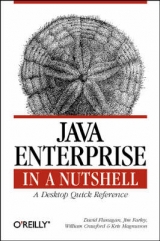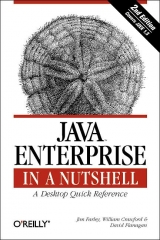Java Enterprise in a Nutshell
O'Reilly Media (Verlag)
978-1-56592-483-3 (ISBN)
- Titel ist leider vergriffen;
keine Neuauflage - Artikel merken
"Java Enterprise in a Nutshell" is a quick reference for Java programmers who are writing distributed enterprise applications. The book provides fast-paced tutorials on the following Java Enterprise APIs: JDBC, a vendor-independent API for accessing relational database systems; RMI, a Java-only approach to distributed computing that relies on remote method invocation; Java IDL, a CORBA-based, language-independent approach to distributed computing; Java servlets, a mechanism for extending a web server that allows Java code to perform tasks traditionally handled by CGI scripts; JNDI, a generic Java API for working with networked naming and directory services; and Enterprise JavaBeans, a component model that separates high-level business logic from low-level housekeeping chores like security and transaction management. These APIs are the building blocks of the Java 2 Platform, Enterprise Edition (J2EE), Sun's platform for enterprise computing. J2EE is the standard Java 2 platform with a number of extensions for enterprise development.
"Java Enterprise in a Nutshell" also contains O'Reilly's classic-style, quick-reference material for all of the classes in the various packages that comprise the Enterprise APIs. This material includes the core Enterprise APIs that are part of Java 1.2, as well as numerous standard extensions. The book is a companion to both "Java in a Nutshell, 3rd Edition", which covers the key non-graphical, non-enterprise APIs in Java 1.2, and "Java Foundation Classes in a Nutshell", which describes the graphics- and GUI-related classes of Java 1.2.
David Flanagan is the author of the bestselling Java in a Nutshell. When David isn't busy writing about Java, he is a consulting computer programmer, user interface designer, and trainer. His other books with O'Reilly include JavaScript: The Definitive Guide, Netscape IFC in a Nutshell, X Toolkit Intrinsics Reference Manual, and Motif Tools: Streamlined GUI Design and Programming with the Xmt Library. David has a degree in computer science and engineering from the Massachusetts Institute of Technology. Jim Farley is a software engineer, computer scientist, and IT manager. His recent activities have included heading up the engineering group at the Harvard Business School and bringing good things to life at GE's Research and Development center. He's dealt with computing (distributed and otherwise) in lots of different ways, from automated image inspection to temporal reasoning systems. Jim has bachelor's and master's degrees in computer systems engineering from Rensselaer Polytechnic Institute. William Crawford got involved with web development back in 1995. He has worked at the Children's Hospital Informatics Program in Boston, where he helped develop the first web-based electronic medical record system and was involved in some of the first uses of Java at the enterprise level. He has consulted for a wide variety of institutional clients, including Boston Children's Hospital, Harvard Medical Center, and several Fortune 500 companies. Will currently heads the product development team at Invantage, Inc., a Cambridge, Massachusetts, company developing Java-based intranet tools for the pharmaceutical industry. In his spare time he is an avid photographer, writer, and economics student at Yale University. Kristopher Magnusson is the Open Source Programs Architect at Novell. He edited the original Java Directory Service Interface proposal for JavaSoft in 1996, worked on the Novell JNDI design team as the lead writer, and wrote JNDI sample code and tutorials. He earned a Bachelor's of Science from the University of Utah in 1991 in economics, has been active in the NeXT and open source communities for years, and loves object-oriented design and computing. He lives with his partner, Kristen, in Salt Lake City, where he enjoys community activism, mountain biking, and oenophilia.
Preface PART 1: Introducing the Java Enterprise APIs Chapter 1. Introduction Enterprise Computing Defined Enterprise Computing Demystified The Java Enterprise APIs Enterprise Computing Scenarios Java Enterprise APIs Versus Jini Chapter 2. JDBC JDBC Architecture JDBC Basics JDBC Drivers Connecting to the Database Statements Results Handling Errors Prepared Statements Metadata Transactions Stored Procedures Escape Sequences JDBC 2.0 Chapter 3. Remote Method Invocation Introduction to RMI Defining Remote Objects Creating the Stubs and Skeletons Accessing Remote Objects as a Client Dynamically Loaded Classes Remote Object Activation RMI and Native Method Calls RMI over IIOP Chapter 4. Java IDL The CORBA Architecture Creating CORBA Objects Putting It in the Public Eye Finding Remote Objects What If I Don't Know the Interface? Chapter 5. Java Servlets The Servlet Life Cycle Servlet Basics Servlet Chaining Custom Servlet Initialization Thread Safety Server-Side Includes Cookies Session Tracking Databases and Non-HTML Content The Servlet API 2.1 Chapter 6. JNDI JNDI Architecture A JNDI Example Introducing the Context Looking Up Objects in a Context The NamingShell Application Listing the Children of a Context Creating and Destroying Contexts Binding Objects Accessing Directory Services Modifying Directory Entries Creating Directory Entries Searching a Directory Chapter 7. Enterprise JavaBeans A Note on Evolving Standards EJB Roles Transaction Management Implementing a Basic EJB Object Implementing Session Beans Implementing Entity Beans Deploying an Enterprise JavaBeans Object Using an Enterprise JavaBeans Object Changes in EJB 1.1 Specification PART 2: Enterprise Reference Chapter 8. SQL Reference Relational Databases Data Types Schema Manipulation Commands Data Manipulation Commands Functions Return Codes Chapter 9. RMI Tools rmic rmiregistry rmid serialver Chapter 10. IDL Reference IDL Keywords Identifiers Comments Basic Data Types Constants and Literals Naming Scopes User-Defined Data Types Exceptions Module Declarations Interface Declarations Chapter 11. CORBA Services Reference Naming Service Security Service Event Service Persistent Object Service Life Cycle Service Concurrency Control Service Externalization Service Relationship Service Transaction Service Query Service Licensing Service Property Service Time Service Trading Service Collection Service Chapter 12. Java IDL Tools idltojava tnameserv PART 3: API Quick Reference Chapter 13. The java.rmi Package Chapter 14. The java.rmi.activation Package Chapter 15. The java.rmi.dgc Package Chapter 16. The java.rmi.registry Package Chapter 17. The java.rmi.server Package Chapter 18. The java.sql Package Chapter 19. The javax.ejb Package Chapter 20. The javax.ejb.deployment Package Chapter 21. The javax.jms Package Chapter 22. The javax.naming Package Chapter 23. The javax.naming.directory Package Chapter 24. The javax.naming.spi Package Chapter 25. The javax.servlet Package Chapter 26. The javax.servlet.http Package Chapter 27. The javax.sql Package Chapter 28. The javax.transaction Package Chapter 29. The javax.transaction.xa Package Chapter 30. The org.omg.CORBA Package Chapter 31. The org.omg.CORBA.DynAnyPackage Chapter 32. The org.omg.CORBA.ORBPackage Chapter 33. The org.omg.CORBA.portable Package Chapter 34. The org.omg.CORBA.TypeCodePackage Chapter 35. The org.omg.CosNaming Package Chapter 36. The org.omg.CosNaming.- Chapter 37. Class, Method, and Field Index Index
| Erscheint lt. Verlag | 5.10.1999 |
|---|---|
| Reihe/Serie | Java S. |
| Zusatzinfo | index |
| Verlagsort | Sebastopol |
| Sprache | englisch |
| Maße | 153 x 228 mm |
| Gewicht | 750 g |
| Einbandart | kartoniert |
| Themenwelt | Informatik ► Programmiersprachen / -werkzeuge ► Java |
| Mathematik / Informatik ► Informatik ► Web / Internet | |
| ISBN-10 | 1-56592-483-5 / 1565924835 |
| ISBN-13 | 978-1-56592-483-3 / 9781565924833 |
| Zustand | Neuware |
| Haben Sie eine Frage zum Produkt? |
aus dem Bereich





